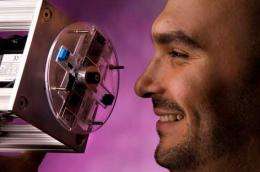Sorting cells, saving lives

(PhysOrg.com) -- A two-day wait for blood test results turned into a hospital stay for Rodrigo Martinez-Duarte’s wife, Anne-Carole. A routine infection spread to her kidneys, making her very sick, while confirmation of her diagnosis was pending.
“If the results hadn’t taken so long, doctors could have begun treatment sooner and my wife might have recovered quicker,” says Martinez-Duarte, a UC Irvine doctoral candidate in mechanical & aerospace engineering.
He hopes a device he’s building will make blood and other cell-sorting tests faster - and cheaper. The technology someday could help diagnose and treat diseases ranging from Alzheimer’s and diabetes to leukemia and HIV.
To support his research efforts, Martinez-Duarte - who was born in Mexico and studied electrical engineering at Tecnologico de Monterrey before coming to UCI in 2005 - has been awarded a $10,000 Public Impact Fellowship from UCI’s Graduate Division.
Many diagnostic tests and therapies are based on sorting and isolating cells. Current methods are costly and time-consuming because of their complexity. Sorter machines can sell for thousands of dollars and weigh hundreds of pounds. Antibodies needed to identify cells are also expensive and require special handling by skilled personnel.
The device Martinez-Duarte is developing sorts cells using electric fields instead of antibodies. Cells have properties that respond to different frequencies. Turn a particular electric field on, and targeted cells can be manipulated at will. The technique, called dielectrophoresis, dates to the 1970s but hasn’t gained popularity in clinical settings because the equipment involved is often bulky and complicated.
Martinez-Duarte’s innovation was to adapt DEP to a medium the size and shape of a compact disc. Cell-containing fluid on the disc can be controlled by changing the disc’s rotation speed and other parameters. The goal is an automated process in which a technician could load a sample, choose a sorting program and obtain results in just a few minutes.
Martinez-Duarte and his colleagues in Chancellor’s Professor Marc Madou’s lab hope the device will be in clinical use within the next few years.
If diagnosed and treated in a timely manner, many diseases can be fought more efficiently. For example, HIV patients must have their CD4 cells continuously monitored to determine the right time to start antiretroviral therapy.
Affordable cell-sorting instruments could also make promising stem cell treatments more widely available. At least half the cost of a bone marrow transplant now goes toward obtaining a purified cell population. Although not always successful, these transplants can mean survival for hundreds of thousands of leukemia patients.
Says Martinez-Duarte: “The advances of medicine will only have limited impact if timely diagnostics and treatments aren’t available to the majority of people.”















